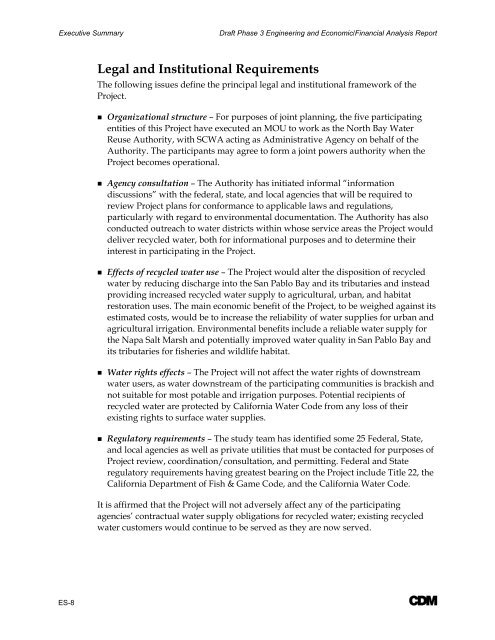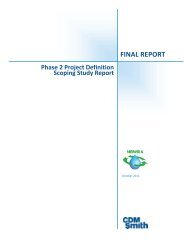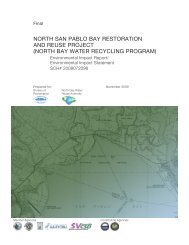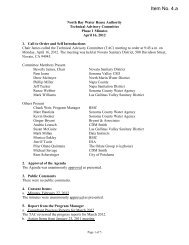Phase 3 Feasibility Report (Table of Contents & Executive Summary)
Phase 3 Feasibility Report (Table of Contents & Executive Summary)
Phase 3 Feasibility Report (Table of Contents & Executive Summary)
Create successful ePaper yourself
Turn your PDF publications into a flip-book with our unique Google optimized e-Paper software.
<strong>Executive</strong> <strong>Summary</strong><br />
Draft <strong>Phase</strong> 3 Engineering and Economic/Financial Analysis <strong>Report</strong><br />
Legal and Institutional Requirements<br />
The following issues define the principal legal and institutional framework <strong>of</strong> the<br />
Project.<br />
• Organizational structure – For purposes <strong>of</strong> joint planning, the five participating<br />
entities <strong>of</strong> this Project have executed an MOU to work as the North Bay Water<br />
Reuse Authority, with SCWA acting as Administrative Agency on behalf <strong>of</strong> the<br />
Authority. The participants may agree to form a joint powers authority when the<br />
Project becomes operational.<br />
• Agency consultation – The Authority has initiated informal “information<br />
discussions” with the federal, state, and local agencies that will be required to<br />
review Project plans for conformance to applicable laws and regulations,<br />
particularly with regard to environmental documentation. The Authority has also<br />
conducted outreach to water districts within whose service areas the Project would<br />
deliver recycled water, both for informational purposes and to determine their<br />
interest in participating in the Project.<br />
• Effects <strong>of</strong> recycled water use – The Project would alter the disposition <strong>of</strong> recycled<br />
water by reducing discharge into the San Pablo Bay and its tributaries and instead<br />
providing increased recycled water supply to agricultural, urban, and habitat<br />
restoration uses. The main economic benefit <strong>of</strong> the Project, to be weighed against its<br />
estimated costs, would be to increase the reliability <strong>of</strong> water supplies for urban and<br />
agricultural irrigation. Environmental benefits include a reliable water supply for<br />
the Napa Salt Marsh and potentially improved water quality in San Pablo Bay and<br />
its tributaries for fisheries and wildlife habitat.<br />
• Water rights effects – The Project will not affect the water rights <strong>of</strong> downstream<br />
water users, as water downstream <strong>of</strong> the participating communities is brackish and<br />
not suitable for most potable and irrigation purposes. Potential recipients <strong>of</strong><br />
recycled water are protected by California Water Code from any loss <strong>of</strong> their<br />
existing rights to surface water supplies.<br />
• Regulatory requirements – The study team has identified some 25 Federal, State,<br />
and local agencies as well as private utilities that must be contacted for purposes <strong>of</strong><br />
Project review, coordination/consultation, and permitting. Federal and State<br />
regulatory requirements having greatest bearing on the Project include Title 22, the<br />
California Department <strong>of</strong> Fish & Game Code, and the California Water Code.<br />
It is affirmed that the Project will not adversely affect any <strong>of</strong> the participating<br />
agencies’ contractual water supply obligations for recycled water; existing recycled<br />
water customers would continue to be served as they are now served.<br />
ES-8<br />
A








